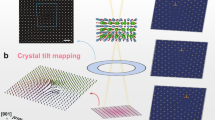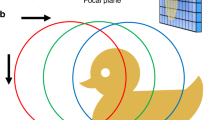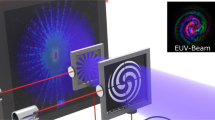Abstract
Nanoscale spin textures, especially magnetic skyrmions, have attracted intense interest as candidate high-density and power-efficient information carriers for spintronic devices1,2. Facilitating a deeper understanding of sub-hundred-nanometre to atomic-scale spin textures requires more advanced magnetic imaging techniques3,4,5. Here we demonstrate a Lorentz electron ptychography method that can enable high-resolution, high-sensitivity magnetic field imaging for widely available electron microscopes. The resolution of Lorentz electron ptychography is not limited by the usual diffraction limit of lens optics, but instead is determined by the maximum scattering angle at which a statistically meaningful dose can still be recorded—this can be an improvement of up to 2–6 times depending on the allowable dose. Using FeGe as the model system, we realize a more accurate magnetic field measurement of skyrmions with an improved spatial resolution and sensitivity by also correcting the probe-damping effect from the imaging optics via Lorentz electron ptychography. This allows us to directly resolve subtle internal structures of magnetic skyrmions near the skyrmion cores, boundaries and dislocations in an FeGe single crystal. Our study establishes a quantitative, high-resolution magnetic microscopy technique that can reveal nanoscale spin textures, especially magnetization discontinuities and topological defects in nanomagnets6. The technique’s high-dose efficiency should also make it well suited for the exploration of magnetic textures in electron radiation-sensitive materials such as organic or molecular magnets7.
This is a preview of subscription content, access via your institution
Access options
Access Nature and 54 other Nature Portfolio journals
Get Nature+, our best-value online-access subscription
$29.99 / 30 days
cancel any time
Subscribe to this journal
Receive 12 print issues and online access
$259.00 per year
only $21.58 per issue
Buy this article
- Purchase on Springer Link
- Instant access to full article PDF
Prices may be subject to local taxes which are calculated during checkout




Similar content being viewed by others
Data availability
The full raw experimental data is available via Zenodo at https://doi.org/10.5281/zenodo.6684163 (ref. 47).
Code availability
The source code for LEP is available via Zenodo at https://doi.org/10.5281/zenodo.4659690 (ref. 48).
References
Fert, A., Cros, V. & Sampaio, J. Skyrmions on the track. Nat. Nanotechnol. 8, 152–156 (2013).
Mathur, N., Stolt, M. J. & Jin, S. Magnetic skyrmions in nanostructures of non-centrosymmetric materials. APL Mater. 7, 120703 (2019).
Yu, X. Z. et al. Real-space observation of a two-dimensional skyrmion crystal. Nature 465, 901–904 (2010).
Milde, P. et al. Unwinding of a skyrmion lattice by magnetic monopoles. Science 340, 1076–1080 (2013).
Park, H. S. et al. Observation of the magnetic flux and three-dimensional structure of skyrmion lattices by electron holography. Nat. Nanotechnol. 9, 337–342 (2014).
Braun, H.-B. Topological effects in nanomagnetism: from superparamagnetism to chiral quantum solitons. Adv. Phys. 61, 1–116 (2012).
Coronado, E. Molecular magnetism: from chemical design to spin control in molecules, materials and devices. Nat. Rev. Mater. 5, 87–104 (2020).
Nagaosa, N. & Tokura, Y. Topological properties and dynamics of magnetic skyrmions. Nat. Nanotechnol. 8, 899–911 (2013).
Mühlbauer, S. et al. Skyrmion lattice in a chiral magnet. Science 323, 915–919 (2009).
Shibata, K. et al. Large anisotropic deformation of skyrmions in strained crystal. Nat. Nanotechnol. 10, 589–592 (2015).
Donnelly, C. et al. Three-dimensional magnetization structures revealed with X-ray vector nanotomography. Nature 547, 328–331 (2017).
Rana, A. et al. Direct observation of 3D topological spin textures and their interactions using soft X-ray vector ptychography. Preprint at https://doi.org/10.48550/arXiv.2104.12933 (2021).
Bode, M. et al. Atomic spin structure of antiferromagnetic domain walls. Nat. Mater. 5, 477–481 (2006).
McVitie, S. & Cushley, M. Quantitative Fresnel Lorentz microscopy and the transport of intensity equation. Ultramicroscopy 106, 423–431 (2006).
Lichte, H. Performance limits of electron holography. Ultramicroscopy 108, 256–262 (2008).
McVitie, S. et al. Aberration corrected Lorentz scanning transmission electron microscopy. Ultramicroscopy 152, 57–62 (2015).
Tate, M. W. et al. High dynamic range pixel array detector for scanning transmission electron microscopy. Microsc. Microanal. 22, 237–249 (2016).
Ophus, C. Four-dimensional scanning transmission electron microscopy (4D-STEM): from scanning nanodiffraction to ptychography and beyond. Microsc. Microanal. 25, 563–582 (2019).
Chapman, J., Batson, P., Waddell, E. & Ferrier, R. The direct determination of magnetic domain wall profiles by differential phase contrast electron microscopy. Ultramicroscopy 3, 203–214 (1978).
Nguyen, K. X. et al. Disentangling magnetic and grain contrast in polycrystalline FeGe thin films using four-dimensional Lorentz scanning transmission electron microscopy. Phys. Rev. Appl. 17, 034066 (2022).
Aharonov, Y. & Bohm, D. Significance of electromagnetic potentials in the quantum theory. Phys. Rev. 115, 485–491 (1959).
Yu, X. Z. et al. Near room-temperature formation of a skyrmion crystal in thin-films of the helimagnet FeGe. Nat. Mater. 10, 106–109 (2011).
Kovács, A. et al. Mapping the magnetization fine structure of a lattice of Bloch-type skyrmions in an FeGe thin film. Appl. Phys. Lett. 111, 192410 (2017).
McGrouther, D. et al. Internal structure of hexagonal skyrmion lattices in cubic helimagnets. New J. Phys. 18, 095004 (2016).
Mermin, N. D. The topological theory of defects in ordered media. Rev. Mod. Phys. 51, 591–648 (1979).
Milnor, J. W. Topology From the Differentiable Viewpoint (Press Of Virginia, 1965).
Chen, Z. et al. Mixed-state electron ptychography enables sub-angstrom resolution imaging with picometer precision at low dose. Nat. Commun. 11, 2994 (2020).
Suzuki, T. et al. Improvement of the accuracy of phase observation by modification of phase-shifting electron holography. Ultramicroscopy 118, 21–25 (2012).
Boureau, V. et al. High-sensitivity mapping of magnetic induction fields with nanometer-scale resolution: comparison of off-axis electron holography and pixelated differential phase contrast. J. Phys. D: Appl. Phys. 54, 085001 (2020).
Close, R., Chen, Z., Shibata, N. & Findlay, S. D. Towards quantitative, atomic-resolution reconstruction of the electrostatic potential via differential phase contrast using electrons. Ultramicroscopy 159, 124–137 (2015).
Isaacson, M. Electron beam induced damage of organic solids: implications for analytical electron microscopy. Ultramicroscopy 4, 193–199 (1979).
Thibault, P. & Menzel, A. Reconstructing state mixtures from diffraction measurements. Nature 494, 68–71 (2013).
Chen, Z. et al. Electron ptychography achieves atomic-resolution limits set by lattice vibrations. Science 372, 826–831 (2021).
Stolt, M. J., Sigelko, X., Mathur, N. & Jin, S. Chemical pressure stabilization of the cubic B20 structure in skyrmion hosting Fe1–xCoxGe alloys. Chem. Mater. 30, 1146–1154 (2018).
Maiden, A. M. & Rodenburg, J. M. An improved ptychographical phase retrieval algorithm for diffractive imaging. Ultramicroscopy 109, 1256–1262 (2009).
Rodenburg, J. M. & Bates, R. H. T. The theory of super-resolution electron microscopy via Wigner-distribution deconvolution. Philos. Trans. R Soc. A 339, 521–553 (1992).
Thibault, P. & Guizar-Sicairos, M. Maximum-likelihood refinement for coherent diffractive imaging. New J. Phys. 14, 063004 (2012).
Odstrcil, M., Menzel, A. & Guizar-Sicairos, M. Iterative least-squares solver for generalized maximum-likelihood ptychography. Opt. Express 26, 3108–3123 (2018).
Odstrcil, M. et al. Ptychographic coherent diffractive imaging with orthogonal probe relaxation. Opt. Express 24, 8360–8369 (2016).
Reimer, L. Transmission Electron Microscopy (Springer, 1989).
Lubk, A. et al. Nanoscale three-dimensional reconstruction of elastic and inelastic mean free path lengths by electron holographic tomography. Appl. Phys. Lett. 105, 173101 (2014).
Egerton, R. F. & Cheng, S. C. Measurement of local thickness by electron energy-loss spectroscopy. Ultramicroscopy 21, 231–244 (1987).
Bechhoefer, J. Curve fits in the presence of random and systematic error. Am. J. Phys. 68, 424–429 (2000).
Song, D. et al. Quantification of magnetic surface and edge states in an FeGe nanostripe by off-axis electron holography. Phys. Rev. Lett. 120, 167204 (2018).
Mochizuki, M. et al. Thermally driven ratchet motion of a skyrmion microcrystal and topological magnon Hall effect. Nat. Mater. 13, 241–246 (2014).
Vansteenkiste, A. et al. The design and verification of MuMax3. AIP Adv. 4, 107133 (2014).
Chen, Z. & Muller, D. A. Datasets for Lorentz electron ptychography for imaging magnetic textures beyond the diffraction limit. Zenodo https://doi.org/10.5281/zenodo.6684163 (2022).
Chen, Z., Jiang, Y., Muller, D. A. & Odstrcil, M. PtychoShelves_EM, source code for multislice electron ptychography. Zenodo https://doi.org/10.5281/zenodo.4659690 (2021).
Acknowledgements
This work is supported by the DARPA TEE-D18AC00009. Z.C. was partly supported by the PARADIM Materials Innovation Platform in-house program by NSF grant DMR-2039380. M.J.S. and S.J. were supported by NSF ECCS-1609585. This work made use of the Cornell Center for Materials Research facility supported by NSF grant DMR-1719875.
Author information
Authors and Affiliations
Contributions
Z.C., D.A.M., G.D.F. and D.C.R. conceived the project. Z.C. performed the experiments and data analysis under the supervision of D.A.M. E.T. carried out the micromagnetic simulations. Y.J. contributed to the LEP. E.T. and K.X.N. performed the magnetic field calibration of the electron microscope. M.J.S. synthesized the FeGe single crystal under the supervision of S.J. Z.C. wrote the draft with revisions from D.A.M. All the authors discussed the results and implications throughout the investigation and have given approval to the final version of the manuscript.
Corresponding authors
Ethics declarations
Competing interests
Cornell University has licensed the EMPAD hardware to Thermo Scientific (D.M. and K.X.N. each receives 4.4% of the license fee).
Peer review
Peer review information
Nature Nanotechnology thanks Jianwei (John) Miao and the other, anonymous, reviewer(s) for their contribution to the peer review of this work.
Additional information
Publisher’s note Springer Nature remains neutral with regard to jurisdictional claims in published maps and institutional affiliations.
Extended data
Extended Data Fig. 1 Synthesized image modes from the 4D LSTEM dataset used in Fig. 1.
a, Center-of-mass (CoM) along horizontal direction (x-axis) ; b, CoM along vertical direction (y-axis); c, Annular dark-field (ADF) image; d, Thickness determined from the diffraction. Scale bar is 50 nm.
Extended Data Fig. 2 Discontinuity near skyrmion boundaries.
a, b, Magnitude and direction of lateral magnetic field of skyrmion lattice in FeGe, respectively. Scale bar is 50 nm. c, d, Magnitude (c) and direction (d) of the magnetic field along the blue dashed line marked on (a) and (b). e & f, Magnitude (e) and direction (f) of the magnetic field along the black dashed line marked on (a) and (b). In order to show the reversal of the magnetic field direction across the boundaries, the line for (d) and (f) is slightly away the skyrmion boundary. The inset in (e) is a cropped region of (a) with arrows indicating the local maxima along the skyrmion boundary.
Extended Data Fig. 3 Comparison of measured and simulated magnetization of skyrmion lattice.
a, Experimental measurements of magnetization vector map; b-d, Enlarged magnetization vector maps near the singular points labeled on (a). e-h, Micromagnetic simulations of magnetization of skyrmions lattice and singular points. Scale bar for (a) and (e) is 50 nm, for (b)-(d) and (f)-(h) is 2 nm.
Extended Data Fig. 4 Resolution improvements of ptychography compared to center-of-mass (CoM).
Magnetic field (Bx) from CoM (a) and ptychography (b). c, Line profiles from the position marked by the red line on (a) and (b). The profile from CoM has a further broadening of 12.4 nm (Gaussian, FWHM) compared to that from ptychography (pty_blur).
Extended Data Fig. 5 Simulations for sub-nanometer spatial resolution of ptychography.
a–c, Phase images from iCoM and e–g, from ptychography at different doses; d, The model phase structure used to generate diffraction patterns; h, Radial distribution function of the Fourier intensity of phase images in (a), (c), (e), (g). The model structure contains varying peak distances vertically and the arrows on (d) mark two rows with the distance of 5.2 nm. Scale bar is 50 nm.
Extended Data Fig. 6 Model phase image for ptychography simulations.
a, Original phase image for ptychography simulations generated from arrays of two-dimensional Gaussian functions; b, Field strength along horizontal direction from (a). c, d, Phase and field retrieved from ptychography with an illuminating dose of 1 e− Å−2, respectively. e, f, Phase and field retrieved from ptychography with an illuminating dose of 10 e− Å−2, respectively. Scale bar is 30 nm.
Supplementary information
Supplementary Information
Supplementary Figs. 1–8.
Rights and permissions
Springer Nature or its licensor (e.g. a society or other partner) holds exclusive rights to this article under a publishing agreement with the author(s) or other rightsholder(s); author self-archiving of the accepted manuscript version of this article is solely governed by the terms of such publishing agreement and applicable law.
About this article
Cite this article
Chen, Z., Turgut, E., Jiang, Y. et al. Lorentz electron ptychography for imaging magnetic textures beyond the diffraction limit. Nat. Nanotechnol. 17, 1165–1170 (2022). https://doi.org/10.1038/s41565-022-01224-y
Received:
Accepted:
Published:
Issue Date:
DOI: https://doi.org/10.1038/s41565-022-01224-y
This article is cited by
-
A closer look at spin textures
Nature Nanotechnology (2023)



